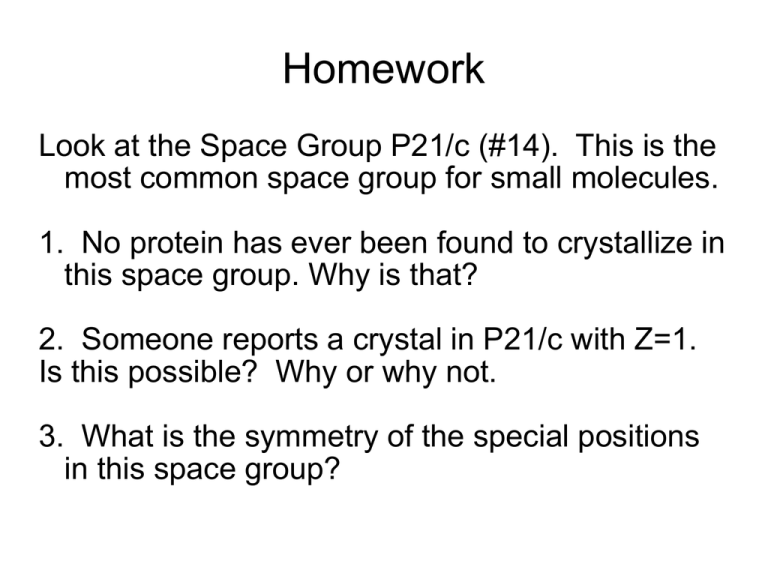Document
advertisement

Homework Look at the Space Group P21/c (#14). This is the most common space group for small molecules. 1. No protein has ever been found to crystallize in this space group. Why is that? 2. Someone reports a crystal in P21/c with Z=1. Is this possible? Why or why not. 3. What is the symmetry of the special positions in this space group? Lesson 11: Adding Translation Define pure translation within a cell—centering Combine translation with other symmetry operations to produce a new operations Rotation + translation = screw axis Reflection + translation = glide plane Cell Centering • • • • Remember cell centering is used to increase the symmetry of a unit cell. Centering involves adding one or more purely translational operations. The result is that one or more fragments in the unit cell are related by a translation. Note-- this does NOT mean there is a fragment situated about a certain point. Centering Types • Centering is indicated by a capital letter at the start of the H-M cell name. • Face Centering – A centering (0, ½, ½)(so x,y,z = x,½+y,½+z for every point) – B centering (½, 0, ½) – C centering (½, ½, 0) – F centering – A+B+C centering (Face centered) • Body Centering – I centering –(½, ½, ½) (Body Centered) • No Centering P for primitive Rhombohedral Centering • It is always possible to take a rhombohedral cell (a=b=c and convert it to a hexagonal cell (a=b . • The hexagonal cell will have 3 times the volume and be rhomohedral centered—R • (2/3, 1/3, 1/3) (1/3, 2/3, 2/3) • Today rhombohedral cells are always reported in their hexagonal form. Screw Axes • • • The screw axis is a combination of rotation and translation. Translation is always along the line that is the rotation axis Since neither rotation or translation change one enantiomer into the other, this symmetry operation can be present in optically active crystals. This direction is determined by the location in the H-M name as we saw last time. Pmm21 implies the screw is along c. A translation by 2/3 generates a point at 1/3 Glide Planes • A glide plane is a mirror followed by a translation of ½ the length of the vector in the plane of the mirror. • The translation can be along an axis in the plane (a,b,c) or along the diagonal (n) • The glide plane is indicated by a lower case letter indicating the direction of translation. • The axis perpendicular to the plane is found from the position in the H-M symbol • The translation is always in the mirror plane. • Since this involves a mirror, it cannot be in optically active crystals. An example H-M Glide Plane • • • A letter a, b, c, or n indicates the direction of the translation. The letter n represents a glide along the diagonal The location of the symbol in the H-M name indicates what axis is perpendicular to the mirror Example Pnma—there is a glide plane with a mirror perpendicular to a and a translation in the bc diagonal, a mirror perpendicular to b and a glide plane perpendicular to c with a translation along a Diamond Glide • Symbol d • Reflection followed by ¼ translation along the diagonal of the mirror plane • Very Rare—thank goodness Homework Is there anything wrong with the proposed space group Pbac? If so what. Is there a difference between 21 and 63? If so what is it.









